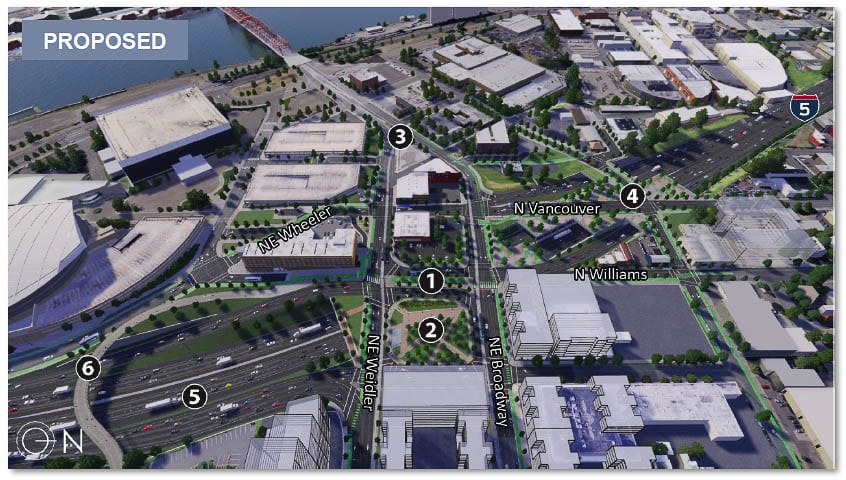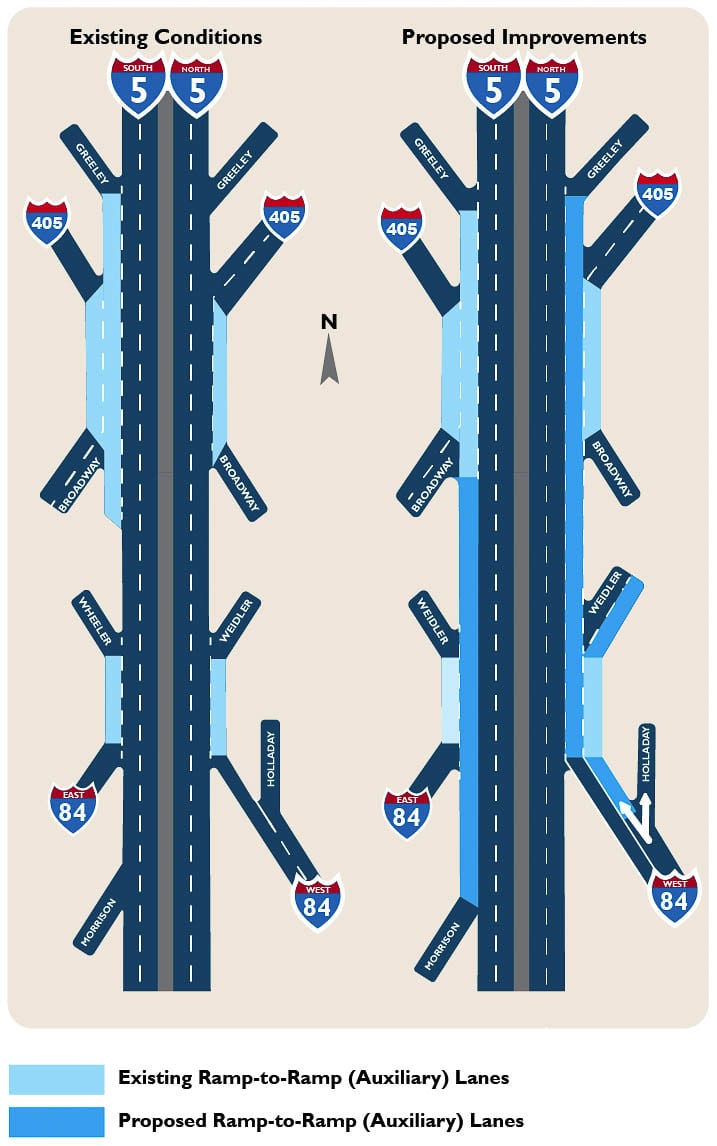$795 million project to include two “highway covers” over Interstate 5
On Friday, the Federal Highway Administration (FHA) issued a Finding of No Significant Impact for the I-5 Rose Quarter Improvement Project, joined with a Revised Environmental Assessment. This marks the completion of the environmental review phase under the National Environmental Policy Act (NEPA) for the project and provides direction to proceed with designing the Build Alternative.
This project is of interest to Clark County residents as over 70,000 commute to Oregon for work. Many use Interstate 5 which has been congested for decades. This Rose Quarter Improvement Project will add no new through lanes to I-5, but will extend auxiliary lanes designed to enhance safety and reduce accidents.
The original project was included in Oregon HB2017, and was allocated $450 million. That bill also included language allowing for tolling on both I-5 and I-205, beginning “at the border” with Washington.

The projected cost has ballooned 76 percent to $795 million, causing many to fear tolls paid by Southwest Washington citizens will be used to pay for the additional cost of what is now being termed a “community redevelopment project.’’ The Oregon Department of Transportation (ODOT) is moving forward with two test projects of tolling, one on I-205 and the other on I-5 to include the Rose Quarter.
In coordination with the FHA, and in compliance with the NEPA, the Oregon Department of Transportation published the Revised Environmental Assessment and the Finding of No Significant Impact for the I-5 Rose Quarter Improvement Project. The Revised Environmental Assessment includes copies of all comments received during the 45-day comment period on the 2019 Environmental Assessment and a summary of ODOT’s and FHWA’s comment responses.
In direct response to several public comments, including comments from the city of Portland, the project team took action to modify the design concept to avoid impacts to the Eastbank Esplanade. The southbound segment of I-5 south of I-84 has been modified such that it no longer encroaches over the Eastbank Esplanade. With this change, the project will no longer require construction in the Willamette River.
Also in direct response to partner agency and stakeholder feedback on the Environmental Assessment, in January 2020, the Oregon Transportation Commission directed ODOT to conduct an environmental peer review of the project’s Environmental Assessment analysis on air quality, noise and greenhouse emissions. The peer review panel included air and noise quality experts from around the country who reviewed ODOT’s methodologies and findings to determine if they were conducted correctly.
The Peer Review Report agreed with ODOT’s original findings for air quality, noise, and greenhouse gas emissions impacts for the project and did not suggest that ODOT conduct additional environmental studies. This Peer Review helped support the publication of the Revised Environmental Assessment.
Project Director Megan Channell acknowledged that while this is a milestone for the project there is still more work to do. “While this closes the chapter on the Environmental Assessment, now the real works begin,” she stated. “We are excited to work with the community and our project partners to design and build a project that provides the most community benefit. Moving forward we are centering the project’s process to elevate the voices of the Black community.”
The next chapter includes convening three advisory bodies, the Executive Steering Committee, the Historic Albina Advisory Board, and the Community Oversight Advisory Committee. The Executive Steering Committee convened in May 2020 and is made up of elected and local leadership. The Historic Albina Advisory Board is still being formed but will be made up of community members with ties to historic Albina.

Both groups will help shape the look and feel of the highway covers and local streets for the final project, and will meet on a regular basis moving forward. The Community Oversight Advisory Board convened in March 2019 and provides an oversight for the project’s Disadvantaged Business Enterprise and workforce program.
“The Project is only at 15% design,” said Channell, “and these three committees along with extensive and intentional outreach to community members will guide ODOT and inform the project moving forward.” In addition to the outreach, ODOT announced hiring a Construction Manager/General Contractor team that will unlock opportunities for Disadvantaged Business Enterprises which includes minority- and women-owned businesses.
Learn more about the project and sign up for email updates at:




